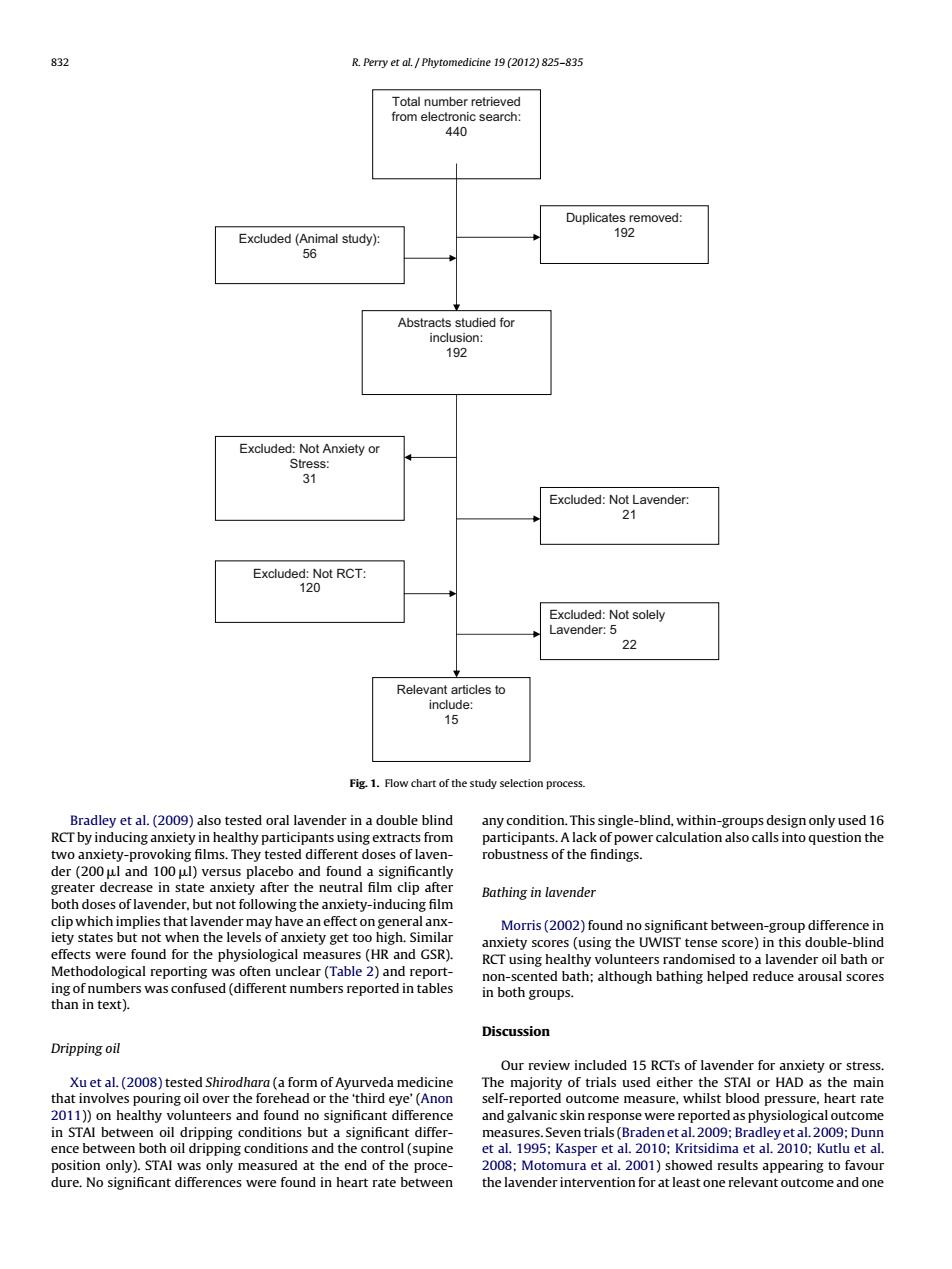正在加载图片...

832 R.Perry et al.Phytomedicine 19(2012)825-835 Total number retrieved from electronic search: 440 Duplicates removed: Excluded (Animal study): 192 56 Abstracts studied for inclusion: 192 Excluded:Not Anxiety or Stress: 31 Excluded:Not Lavender 21 Excluded:Not RCT: 120 Excluded:Not solely Lavender:5 22 事 Relevant articles to include: 15 Fig.1.Flow chart of the study selection process. Bradley et al.(2009)also tested oral lavender in a double blind any condition.This single-blind,within-groups design only used 16 RCT by inducing anxiety in healthy participants using extracts from participants.A lack of power calculation also calls into question the two anxiety-provoking films.They tested different doses of laven- robustness of the findings. der (200 ul and 100 ul)versus placebo and found a significantly greater decrease in state anxiety after the neutral film clip after Bathing in lavender both doses of lavender,but not following the anxiety-inducing film clip which implies that lavender may have an effect on general anx- Morris(2002)found no significant between-group difference in iety states but not when the levels of anxiety get too high.Similar anxiety scores (using the UWIST tense score)in this double-blind effects were found for the physiological measures (HR and GSR) RCT using healthy volunteers randomised to a lavender oil bath or Methodological reporting was often unclear (Table 2)and report- non-scented bath;although bathing helped reduce arousal scores ing of numbers was confused(different numbers reported in tables in both groups. than in text). Discussion Dripping oil Our review included 15 RCTs of lavender for anxiety or stress. Xu et al.(2008)tested Shirodhara (a form of Ayurveda medicine The majority of trials used either the STAl or HAD as the main that involves pouring oil over the forehead or the 'third eye'(Anon self-reported outcome measure,whilst blood pressure,heart rate 2011))on healthy volunteers and found no significant difference and galvanic skin response were reported as physiological outcome in STAI between oil dripping conditions but a significant differ- measures.Seven trials(Bradenet al.2009;Bradleyetal.2009;Dunn ence between both oil dripping conditions and the control (supine et al.1995:Kasper et al.2010;Kritsidima et al.2010:Kutlu et al. position only).STAI was only measured at the end of the proce- 2008:Motomura et al.2001)showed results appearing to favour dure.No significant differences were found in heart rate between the lavender intervention for at least one relevant outcome and one832 R. Perry et al. / Phytomedicine 19 (2012) 825–835 Total number retrieved from electronic search: 440 Duplicates removed: 192 Abstracts studied for inclusion: 192 Relevant articles to include: 15 Excluded (Animal study): 56 Excluded: Not Anxiety or Stress: 31 Excluded: Not RCT: 120 Excluded: Not Lavender: 21 Excluded: Not solely Lavender: 5 22 Fig. 1. Flow chart of the study selection process. Bradley et al. (2009) also tested oral lavender in a double blind RCT by inducing anxiety in healthy participants using extracts from two anxiety-provoking films. They tested different doses of lavender (200 l and 100 l) versus placebo and found a significantly greater decrease in state anxiety after the neutral film clip after both doses of lavender, but not following the anxiety-inducing film clip which implies thatlavender may have an effect on general anxiety states but not when the levels of anxiety get too high. Similar effects were found for the physiological measures (HR and GSR). Methodological reporting was often unclear (Table 2) and reporting of numbers was confused (different numbers reported in tables than in text). Dripping oil Xu et al. (2008) tested Shirodhara (a form of Ayurveda medicine that involves pouring oil over the forehead or the ‘third eye’ (Anon 2011)) on healthy volunteers and found no significant difference in STAI between oil dripping conditions but a significant difference between both oil dripping conditions and the control (supine position only). STAI was only measured at the end of the procedure. No significant differences were found in heart rate between any condition. This single-blind, within-groups design only used 16 participants. A lack of power calculation also calls into question the robustness of the findings. Bathing in lavender Morris (2002) found no significant between-group difference in anxiety scores (using the UWIST tense score) in this double-blind RCT using healthy volunteers randomised to a lavender oil bath or non-scented bath; although bathing helped reduce arousal scores in both groups. Discussion Our review included 15 RCTs of lavender for anxiety or stress. The majority of trials used either the STAI or HAD as the main self-reported outcome measure, whilst blood pressure, heart rate and galvanic skin response were reported as physiological outcome measures. Seven trials (Braden et al. 2009; Bradley et al. 2009; Dunn et al. 1995; Kasper et al. 2010; Kritsidima et al. 2010; Kutlu et al. 2008; Motomura et al. 2001) showed results appearing to favour the lavender intervention for atleast one relevant outcome and one��